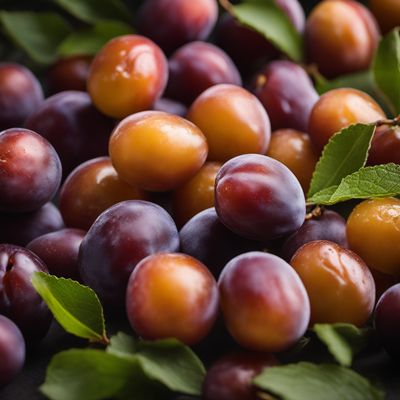
Ingredient
Cherry plums
The Sweet and Tangy Delight: Exploring the World of Cherry Plums
Cherry plums are small, round fruits that resemble cherries in size and plums in taste. They have a smooth, shiny skin that can range in color from yellow to red, and their flesh is juicy and slightly tart. The texture of cherry plums is firm yet tender, making them enjoyable to eat both raw and cooked. These fruits are known for their vibrant flavor and are often described as a delightful combination of sweet and tangy.
Origins and history
Cherry plums are believed to have originated in Asia, specifically in the regions of China and Japan. They have a long history and have been cultivated for centuries. Cherry plums were introduced to Europe by the Romans and have since become naturalized in many parts of the continent. Today, they are grown in various countries around the world, including the United States, Australia, and South Africa.
Nutritional information
Cherry plums are a good source of vitamins A and C, as well as dietary fiber. They are low in calories, with approximately 30 calories per 100 grams.
Allergens
There are no known allergens associated with cherry plums.
How to select
When selecting cherry plums, look for fruits that are plump, firm, and free from blemishes or bruises. The skin should have a vibrant color and a slight give when gently pressed. Avoid fruits that are overly soft or have wrinkled skin, as they may be overripe.
Storage recommendations
To maintain the freshness and quality of cherry plums, store them in the refrigerator in a perforated plastic bag. They can be kept for up to a week. For longer-term storage, cherry plums can be frozen or preserved as jams or jellies.
How to produce
Cherry plums can be grown by planting the seeds or by grafting a desired variety onto a rootstock. They require well-drained soil and full sun to thrive. With proper care and maintenance, cherry plum trees can produce an abundance of fruits within a few years.
Preparation tips
Cherry plums can be enjoyed fresh as a snack or used in a variety of culinary preparations. They can be added to salads, used in desserts like pies and tarts, or cooked down into sauces and compotes. To remove the pit, simply cut the fruit in half and twist gently to separate the halves. Cherry plums can also be roasted or grilled to enhance their natural sweetness.
Substitutions
If cherry plums are not available, you can substitute them with a combination of cherries and plums to achieve a similar flavor profile.
Culinary uses
Cherry plums are commonly used in jams, jellies, and preserves due to their natural sweetness and tanginess. They can also be used in pies, tarts, and cakes to add a burst of flavor. In savory dishes, cherry plums can be incorporated into sauces, chutneys, and marinades to balance out rich flavors.
Availability
Cherry plums are commonly available in regions where they are cultivated, including Europe, Asia, and North America.
More ingredients from this category » Browse all

Chinese jujubes
The Ancient Fruit: Chinese Jujubes

Plums
The Juicy Gems

Chickasaw plums
The Sweet Gems of the South

Gages
The Sweet and Succulent Delight: Exploring the World of Gages

Klamath plums
The Jewel of Klamath

Sloes
The Bitter-Sweet Berry

Mirabelles
The Golden Gems of Summer

Plumcots
The Perfect Blend: Exploring the Unique Delights of Plumcots

Damsons
The Prized Gems of the Plum Family

Japanese plums
The Delicate Delights of Ume: Unveiling the World of Japanese Plums

Prunus Nadia®
The Exquisite Fusion of Sweetness and Tartness: Prunus Nadia®

American plums
The Sweet and Tart Delight: Exploring the World of American Plums